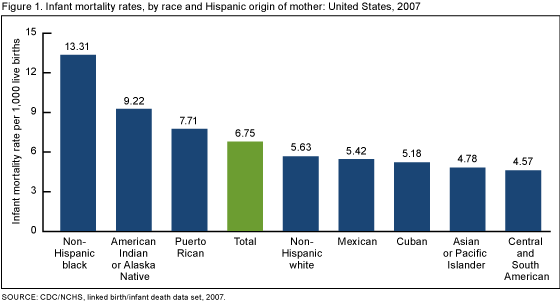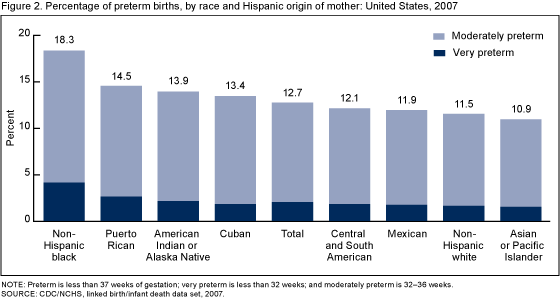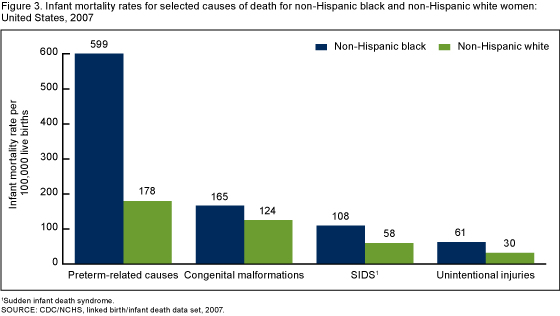Understanding Racial and Ethnic Disparities in U.S. Infant Mortality Rates
On This Page
- Key findings
- U.S. infant mortality rates vary greatly by race and ethnicity.
- Gestational age-specific infant mortality rates vary widely among racial and ethnic groups.
- The percentage of infants born preterm varies widely by maternal race and ethnicity.
- For non-Hispanic black women, preterm-related causes of death account for most of their higher infant mortality risk.
- For Puerto Rican women, preterm-related causes also explain most of their higher infant mortality risk.
- In contrast, higher SIDS rates contribute the most to the infant mortality gap between AIAN and non-Hispanic white women.
- Summary
- Definitions
- Data source and methods
- About the authors
- References
- Suggested citation
NCHS Data Brief No. 74, September 2011
PDF Version (531 KB)
Marian F. MacDorman, Ph.D., and T.J. Mathews, M.S.
Key findings
Data from the 2007 linked birth/infant death data set
- In 2007, the infant mortality rate for non-Hispanic black women was 2.4 times the rate for non-Hispanic white women. American Indian or Alaska Native (AIAN) and Puerto Rican women also had relatively high infant mortality rates.
- The higher infant mortality rate for non-Hispanic black and Puerto Rican women, compared with non-Hispanic white women, was primarily due to their higher levels of preterm births and preterm-related causes of death.
- In contrast, the higher infant mortality rate for AIAN women was mostly due to higher infant mortality rates for term and near-term infants, not to a higher percentage of preterm births.
- Higher infant mortality rates from sudden infant death syndrome contributed the most to the infant mortality gap between AIAN and non-Hispanic white women.
Racial and ethnic disparities in health have generated increasing attention and concern in the past few years (1,2). One of the largest disparities found in health research is racial and ethnic differences in infant mortality (1,2). Disparities in U.S. infant mortality have been apparent since these data began to be collected more than 100 years ago (3). These disparities have persisted and even increased over time, suggesting that not all racial and ethnic groups have benefited equally from social and medical advances (1,4,5). This report examines racial and ethnic disparities in infant mortality rates in the United States with a particular focus on explaining the high infant mortality rates for non-Hispanic black, American Indian or Alaska Native (AIAN), and Puerto Rican women. Two key components of infant mortality are analyzed: gestational age-specific infant mortality rates, and the distribution of births by gestational age. Differences by cause of death are also examined.
Keywords: infant death, racial and ethnic differences, causes of infant death
U.S. infant mortality rates vary greatly by race and ethnicity.
- In 2007, the infant mortality rate for non-Hispanic black women was 13.31 infant deaths per 1,000 live births, 2.4 times the rate for non-Hispanic white women (5.63)

- The infant mortality rate for AIAN women (9.22) was 64 percent higher than the rate for non-Hispanic white women.
- The infant mortality rate for Puerto Rican women (7.71) was 37 percent higher than the rate for non-Hispanic white women.
- In contrast, infant mortality rates for Mexican, Cuban, Central and South American, and Asian or Pacific Islander (API) women were 4–19 percent lower than for non-Hispanic white women.
Gestational age-specific infant mortality rates vary widely among racial and ethnic groups.
- For very preterm infants (less than 32 weeks of gestation), infant mortality rates were 26 percent higher for non-Hispanic black and 14 percent lower for Central and South American infants than for non-Hispanic white infants. Rates for the other racial and ethnic groups were not significantly different from the non-Hispanic white rate. At 32–33 weeks of gestation, differences among groups were not statistically significant (Table).
- Differences in gestational age-specific infant mortality were greater for infants at 34 weeks of gestation or more than for shorter gestations. Infant mortality rates for AIAN women—those with the highest mortality rates at this gestation—were twice those for non-Hispanic white women. For non-Hispanic black women, infant mortality rates were 33–76 percent higher for each gestational age grouping of 34 weeks or more than for non-Hispanic white women.
- For Puerto Rican women, gestational age-specific infant mortality rates were generally not significantly different compared with non-Hispanic white women.
Table. Gestational age-specific infant mortality rates, by race and Hispanic origin of mother: United States, 2007
| Gestational age (weeks) | |||||||
|---|---|---|---|---|---|---|---|
| Total | Less than 32 | 32–33 | 34–36 | 37–38 | 39–41 | 42 or more | |
| Total | 6.75 | 178.36 | 16.12 | 7.42 | 3.09 | 2.07 | 2.62 |
| Non-Hispanic white | 5.63 | 165.61 | 16.23 | 7.10 | 2.95 | 1.95 | 2.51 |
| Non-Hispanic black | 13.31 | 209.03 | 16.91 | 9.42 | 4.45 | 3.43 | 4.40 |
| Hispanic | 5.51 | 158.71 | 14.64 | 6.48 | 2.63 | 1.70 | 2.04 |
| Mexican | 5.42 | 161.31 | 15.11 | 6.67 | 2.69 | 1.66 | 2.10 |
| Puerto Rican | 7.71 | 172.18 | * | 8.15 | 3.11 | 2.32 | * |
| Central and South American | 4.57 | 142.09 | 13.52 | 5.24 | 2.02 | 1.41 | * |
| American Indian or Alaska Native | 9.22 | 156.99 | 28.51 | 14.27 | 6.14 | 3.79 | * |
| Asian or Pacific Islander | 4.78 | 173.30 | 14.84 | 5.59 | 2.12 | 1.43 | 1.69 |
* Figure does not meet standards of reliability or precision; based on fewer than 20 infant deaths in the numerator.
NOTE: Reliable rates cannot be computed for the Cuban population due to the small number of infant deaths (88).
- Infant mortality rates were lower for Central and South American and API women at 34 weeks or more, and for Mexican women at 39–41 weeks, compared with non-Hispanic white women.
The percentage of infants born preterm varies widely by maternal race and ethnicity.
- Nearly one in five infants of non-Hispanic black women (18.3 percent) were born preterm. This was the highest level among the racial and ethnic groups—60 percent higher than the percentage for non-Hispanic white women (11.5 percent) (Figure 2).
- For non-Hispanic black women, the percentage of very preterm births (less than 32 weeks of gestation) was 4.1 percent, more than twice the percentage for non-Hispanic white women (1.6 percent). Very preterm infants have the highest infant mortality risk, so that differences in very preterm births have a large effect on the overall infant mortality rate.
- Compared with non-Hispanic white women, the percentage of preterm births was 3–26 percent higher for Mexican, Central and South American, Cuban, and Puerto Rican women.
- API women had the lowest percentage of preterm births—5 percent lower than for non-Hispanic white women.

For non-Hispanic black women, preterm-related causes of death account for most of their higher infant mortality risk.
- Infant mortality rates were higher for non-Hispanic black than for non-Hispanic white women for all four of the causes of death shown in (Figure 3). The largest difference was for preterm-related causes, for which the non-Hispanic black rate was more than three times the non-Hispanic white rate.
- Infant mortality rates for sudden infant death syndrome (SIDS), congenital malformations, and unintentional injuries were also substantially higher for non-Hispanic black than for non-Hispanic white women.
- Preterm-related causes accounted for more than one-half of the difference (55 percent) between the non-Hispanic black and the non-Hispanic white infant mortality rate. SIDS accounted for 6 percent, congenital malformations 5 percent, and unintentional injuries 4 percent of the difference; thus, 71 percent of the difference can be attributed to these four causes (calculation not shown—see “Data Source and Methods”).

For Puerto Rican women, preterm-related causes also explain most of their higher infant mortality risk.
- Infant mortality rates for preterm-related causes were 71 percent higher, and rates from congenital malformations were 10 percent higher, for Puerto Rican women than for non-Hispanic white women (Figure 4).
- SIDS rates were the same for Puerto Rican and non-Hispanic white women, while a reliable infant mortality rate for unintentional injuries could not be computed for Puerto Rican mothers due to the small number of deaths in that category.
- Preterm-related causes of death accounted for 61 percent of the difference between Puerto Rican and non-Hispanic white infant mortality rates, and congenital malformations accounted for 6 percent of the difference; thus, these two causes accounted for 67 percent of the difference (calculation not shown—see “Data Source and Methods”).

In contrast, higher SIDS rates contribute the most to the infant mortality gap between AIAN and non-Hispanic white women.
- The AIAN infant mortality rate from SIDS was 2.4 times, and the rate from unintentional injuries was 2.3 times, the non-Hispanic white rate (Figure 5). The AIAN infant mortality rates for these two causes of death were the highest among the racial and ethnic groups studied.
- The AIAN infant mortality rate from congenital malformations was 48 percent higher, and the rate from preterm-related causes was 26 percent higher, than for non-Hispanic white women.
- SIDS accounted for 23 percent of the difference between the AIAN and the non-Hispanic white infant mortality rates. Congenital malformations accounted for 17 percent, preterm-related causes accounted for 13 percent, and unintentional injuries accounted for 11 percent of the difference; thus, the four causes combined accounted for 64 percent of the difference (calculation not shown—see “Data Source and Methods”).

Summary
In the United States, different racial and ethnic groups have very different infant mortality patterns. When assessing the relative contribution of the percentage of preterm births and gestational age-specific infant mortality rates to racial and ethnic infant mortality differences, we found that for non-Hispanic black women, 78 percent of their elevated infant mortality rate compared with non-Hispanic white women was due to their higher percentage of preterm births, while 22 percent was due to higher gestational age-specific infant mortality rates (primarily at 34 weeks of gestation or more). For Puerto Rican women, their elevated infant mortality rate compared with non-Hispanic white women was entirely due to their higher percentage of preterm births. However, AIAN women had a very different infant mortality pattern: 76 percent of their higher infant mortality rate compared with non-Hispanic white women was due to their higher gestational age-specific infant mortality rates (primarily at 34 weeks or more), and only 24 percent was due to their higher percentage of preterm births.
These findings are consistent with the cause-of-death analysis, which found that for both non-Hispanic black and Puerto Rican women, most of their higher infant mortality rate compared with non-Hispanic white women was due to preterm-related causes. In contrast, for AIAN women, the infant mortality rate from SIDS was 2.4 times, and the rate from unintentional injuries was 2.3 times, the non-Hispanic white rate. Infant mortality rates for non-Hispanic black women would be reduced by 71 percent, those for AIAN women by 64 percent, and those for Puerto Rican women by 67 percent if rates from preterm-related causes, congenital malformations, SIDS, and unintentional injuries could be reduced to non-Hispanic white levels.
The different infant mortality patterns for non-Hispanic black, Puerto Rican, and AIAN women suggest different prevention strategies (6,7). In addition, because the percentage of preterm births for all U.S. racial and ethnic groups is higher than in other developed countries, all U.S. racial and ethnic groups might benefit from prematurity prevention efforts (8,9).
Definitions
Infant death: Death of an infant before his or her first birthday.
Infant mortality rate: Number of infant deaths per 1,000 live births.
Gestational age-specific infant mortality rate: Number of infant deaths for a specific gestational age group (for example, 32–33 weeks of gestation), divided by the number of live births for the same gestational age group times 1,000.
Cause-specific infant mortality rate: Number of infant deaths from a particular cause of death (e.g., SIDS) per 100,000 live births.
Preterm birth: Birth before 37 completed weeks of gestation.
Very preterm birth: Birth before 32 completed weeks of gestation.
Late preterm birth: Birth at 34–36 weeks of gestation.
Early term birth: Birth at 37–38 weeks of gestation.
Data source and methods
This report is based on data from the 2007 linked birth/infant death data set (5). In the linked data set, information from the death certificate is linked to information from the birth certificate for each infant under age 1 year who died in the 50 states, District of Columbia, and selected U.S. territories. In the linked data set, the more reliable racial and ethnic data from the birth certificate is used in both the numerator and denominator of infant mortality rate computations, thus providing greater accuracy than other data sources.
The percent contribution of causes of death to the racial and ethnic infant mortality gap is computed as the racial and ethnic difference in infant mortality rates for specific causes divided by the racial and ethnic difference in the overall infant mortality rate times 100.
The percent contribution of the gestational age distribution and gestational age-specific infant mortality rates to racial and ethnic differences in infant mortality rates is computed using the Kitagawa method, which is described in detail elsewhere (10). Preterm-related causes of death are those in which 75 percent or more of infants whose deaths were attributed to that cause were born at less than 37 weeks of gestation, and the cause of death was a direct consequence of preterm birth based on a clinical evaluation and review of the literature; this measure is described in detail elsewhere (5,11,12).
About the authors
Marian F. MacDorman and T.J. Mathews are with the Centers for Disease Control and Prevention’s National Center for Health Statistics, Division of Vital Statistics, Reproductive Statistics Branch.
References
- Centers for Disease Control and Prevention. CDC health disparities and inequalities report— United States, 2011. MMWR 60(Suppl):1–116. 2011.
- U.S. Department of Health and Human Services. Healthy people 2020 framework [PDF – 253 KB]. 2010.
- Shapiro S, Schlesinger ER, Nesbitt REL Jr. Infant, perinatal, maternal and childhood mortality in the United States. Cambridge, MA: Harvard University Press. 1968.
- Krieger N, Rehkopf DH, Chen JT, Waterman PD, Marcelli E, Kennedy M. The fall and rise of US inequities in premature mortality: 1960–2002. PLoS Med 5(2):e46. 2008.
- Mathews TJ, MacDorman MF. Infant mortality statistics from the 2007 linked birth/infant death data set. National vital statistics reports, vol 59 no 6. Hyattsville, MD: National Center for Health Statistics. 2011.
- Sappenfield WM, Peck MG, Gilbert CS, Haynatzka VR, Bryant T 3rd. Perinatal periods of risk: Analytic preparation and phase 1 analytic methods for investigating feto-infant mortality. Matern Child Health J 14(6):838–50. 2010.
- Sappenfield WM, Peck MG, Gilbert CS, Haynatzka VR, Bryant T 3rd. Perinatal periods of risk: Phase 2 analytic methods for further investigating feto-infant mortality. Matern Child Health J 14(6):851–63. 2010.
- MacDorman MF, Mathews TJ. Behind international rankings of infant mortality: How the United States compares with Europe. NCHS data brief, no 23. Hyattsville, MD: National Center for Health Statistics. 2009.
- Ananth CV, Liu S, Joseph KS, Kramer MS. A comparison of foetal and infant mortality in the United States and Canada. Int J Epidemiol 38:480–9. 2009.
- Kitagawa EM. Components of a difference between two rates. J Am Stat Assoc 50(272):1168–94. 1955.
- Callaghan WM, MacDorman MF, Rasmussen SA, Qin C, Lackritz EM. The contribution of preterm birth to infant mortality rates in the United States. Pediatrics 118:1566–73. 2006.
- MacDorman MF, Callaghan WM, Mathews TJ, Hoyert DL, Kochanek KD. Trends in preterm-related infant mortality by race and ethnicity, United States, 1999–2004. Int J Health Serv 37(4):635–41. 2007.
Suggested citation
MacDorman MF, Mathews TJ. Understanding racial and ethnic disparities in U.S. infant mortality rates. NCHS data brief, no 74. Hyattsville, MD: National Center for Health Statistics. 2011.
Copyright information
All material appearing in this report is in the public domain and may be reproduced or copied without permission; citation as to source, however, is appreciated.
National Center for Health Statistics
Edward J. Sondik, Ph.D., Director
Jennifer H. Madans, Ph.D., Associate Director for Science
Division of Vital Statistics
Charles J. Rothwell, M.S., Director
- Page last reviewed: November 6, 2015
- Page last updated: September 14, 2011
- Content source:


 ShareCompartir
ShareCompartir